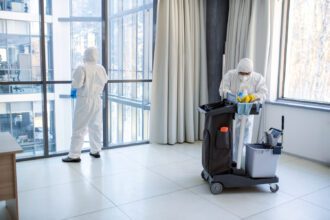As the world struggles to combat the COVID-19 pandemic, commercial cleaning practices have undergone a significant transformation. This shift is crucial in preventing the spread of the virus and ensuring a safe working environment.
Pre-COVID-19 Era: Lax Attitudes Towards Cleaning
Before the pandemic, many businesses took a lackadaisical approach to cleaning. However, this attitude has drastically changed since COVID-19.
In the past, commercial cleaning focused primarily on aesthetics, with an emphasis on making spaces look clean rather than actually being sanitary.
The Pandemic’s Impact: Elevated Cleaning Standards
The rapid spread of COVID-19 has prompted a renewed focus on sanitation and hygiene in commercial settings. Businesses now recognize the importance of maintaining a clean environment to protect employees, customers, and visitors.
The Centers for Disease Control and Prevention (CDC) have issued guidelines for cleaning and disinfecting public spaces, which has led to an increased emphasis on:
- Frequent cleaning and disinfection of high-touch areas
- Proper use of personal protective equipment (PPE)
- Enhanced ventilation systems
Commercial Cleaning Services: Adapting to the New Normal
In response to the pandemic, commercial cleaning services have had to adapt their practices to meet the elevated standards.
Many companies are now offering specialized COVID-19 cleaning and disinfection services, which include:
- Electrostatic sprayers for efficient disinfection
- Ultraviolet (UV) light technology to eliminate germs
- Trained technicians equipped with PPE
The Role of Technology in Commercial Cleaning
The pandemic has accelerated the adoption of innovative technologies in commercial cleaning.
Autonomous cleaning robots and drones are being utilized to:
- Enhance efficiency and productivity
- Reduce labor costs
- Minimize human contact, thereby reducing the risk of transmission
Sustainable Cleaning Practices: A New Priority
In addition to combating COVID-19, businesses are now prioritizing sustainable cleaning practices to reduce their environmental footprint.
This shift towards eco-friendly cleaning products and equipment has been driven by:
- Growing consumer demand for environmentally responsible practices
- Increased awareness of the impact of chemicals on human health and the environment
Employee Training: A Critical Component
The effectiveness of commercial cleaning practices hinges on employee training. It is essential that cleaning staff are equipped with the necessary knowledge and skills to combat COVID-19.
Training programs should cover:
- Proper use of PPE
- Effective cleaning and disinfection techniques
- Safety protocols for handling chemicals and equipment
Challenges Faced by Commercial Cleaning Services
While commercial cleaning services have made significant strides in adapting to the new normal, they still face several challenges.
Some of the key obstacles include:
- Ensuring consistent compliance with evolving guidelines and regulations
- Managing increased demand for specialized cleaning services
- Maintaining profitability amidst rising operational costs
The Future of Commercial Cleaning: Trends and Predictions
As the world continues to navigate the COVID-19 pandemic, commercial cleaning practices will likely undergo further transformation.
Some trends and predictions that are expected to shape the industry include:
- Increased adoption of automation and robotics
- Growing demand for sustainable and eco-friendly cleaning products
- Integration of artificial intelligence (AI) and machine learning (ML) in cleaning protocols
The COVID-19 pandemic has brought about a seismic shift in commercial cleaning practices. As businesses strive to create safe and healthy environments, they must prioritize sanitation, hygiene, and sustainability.
By embracing innovative technologies, sustainable practices, and rigorous training programs, commercial cleaning services can play a vital role in mitigating the spread of COVID-19 and protecting public health.
